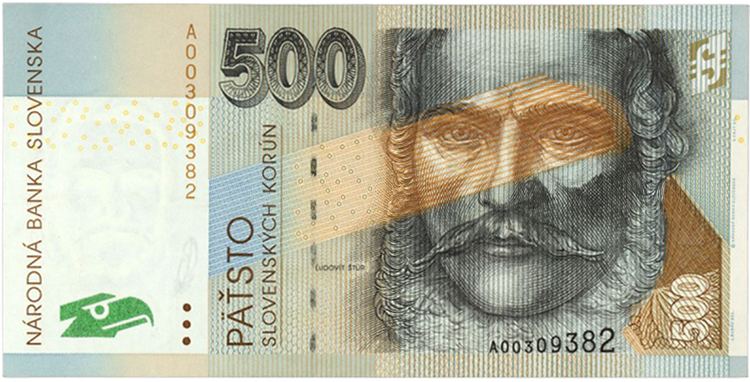Coins 500 Sk 1/100 halier halier h | Code SKK Symbol Sk | |
 | ||
Plural The language(s) of this currency belong(s) to the Slavic languages. There is more than one way to construct plural forms. | ||
The Slovak koruna or Slovak crown (Slovak: slovenská koruna, literally meaning Slovak crown) was the currency of Slovakia between 8 February 1993 and 31 December 2008, and could be used for cash payment until 16 January 2009. The ISO 4217 code was SKK and the local abbreviation was Sk. The Slovak crown (koruna) was also the currency of the Nazi-era Slovak Republic between 1939 and 1945. Both korunas were subdivided into 100 haliers (abbreviated as "hal." or simply "h", singular: halier). The abbreviation is placed after the numeric value.
Contents
Slovakia switched its currency from the koruna to the euro on 1 January 2009, at a rate of 30.1260 korunas to the euro.
In the Slovak language, the nouns "koruna" and "halier" both assume two plural forms. "Koruny" and "haliere" appears after the numbers 2, 3 and 4 and in generic (uncountable) context, with "korún" and "halierov" being used after other numbers. The latter forms also correspond to genitive use in plural.
Koruna of 1939–1945
The koruna (Slovak: koruna slovenská, note the different word ordering from the modern koruna) was the currency of the Slovak Republic from 1939 to 1945. The Slovak koruna replaced the Czechoslovak koruna at par and was replaced by the reconstituted Czechoslovak koruna, again at par. Its abbreviation was Kčs.
Initially, the Slovak koruna was at par with the Bohemian and Moravian koruna, with 10 korunas = 1 Reichsmark. It was devalued, on 1 October 1940, to a rate of 11.62 Slovak korunas to one Reichsmark, while the value of the Bohemian and Moravian currency remained unchanged against the Reichsmark.
Coins
In 1939, coins were introduced in denominations of 10 halierov, 5 and 20 korunas, with 20 and 50 haliers and 1 koruna added in 1940. The 10 and 20 haliers were bronze, the 50 haliers and 1 koruna cupronickel, the 5 korunas nickel and the 20 korunas were silver. In 1942, zinc 5 haliers were introduced and aluminium replaced bronze in the 20 haliers. Aluminium 50 haliers followed in 1943. Silver 10 and 50 korunas were introduced in 1944.
Compared to the pre-war Czechoslovak koruna, the Slovak koruna coins had an additional 50 Ks, the silver content of the 10 and 20 Ks coins was reduced from 700 ‰ to 500 ‰ and all but 5 Ks shrank in physical sizes. The designers were Anton Hám, Andrej Peter, Gejza Angyal, Ladislav Majerský and František Štefunko. Coins were minted in the Kremnica mint.
Banknotes
In 1939, Czechoslovak notes for 100, 500 and 1000 korún were issued with SLOVENSKÝ ŠTÁT overprinted on them for use in Slovakia. That year also saw the introduction of 10 and 20 koruna notes by the government.
Modern koruna
In 1993, the newly independent Slovakia introduced its own koruna, replacing the Czechoslovak koruna at par.
In 1993, coins were introduced in denominations of 10, 20 and 50 haliers, 1, 2, 5 and 10 korunas. The 10- and 20-halier coins were taken out of circulation on 31 December 2003.
The obverse of the coins feature the coat of arms of Slovakia, with motifs from Slovak history on the reverses.
Coins were exchangeable for euros at the National Bank of Slovakia until January 2, 2014.
Banknotes
At midnight on 31 December 1992, the Czechoslovak Republic bifurcated into the Czech Republic and the Slovak Republic. In 1993, the newly independent Slovakia introduced its own koruna, replacing the Czechoslovak koruna at par. Provisional banknotes were issued in denominations of 20, 50, 100, 500, and 1,000 korún by affixing stamps bearing the coat of arms of Slovakia and the denomination to Czechoslovak banknotes. The main motifs on the obverses of the banknotes represent important people living in the territory of the present Slovakia in various historical eras. On the reverses, these motifs are completed by depicting places where these people lived and were active.
Slovak banknotes denominated in koruny can be exchanged for euros indefinitely.
Historical exchange rates
The graph shows the value of the euro in korunas from 1999 to December 2008. As may be seen, the currency strengthened as Slovakia's economy did. The koruna joined the ERM II on 28 November 2005 at the rate of € = 38.4550 Sk with a 15% band. On 17 March 2007, this rate was readjusted to 35.4424 Sk with the same band, an 8.5% increase in the value of the koruna. On the same day, 1 euro traded at 33.959 Sk. The central rate of koruna was then adjusted once more on 28 May 2008 to 30.1260 with no change in the band.
